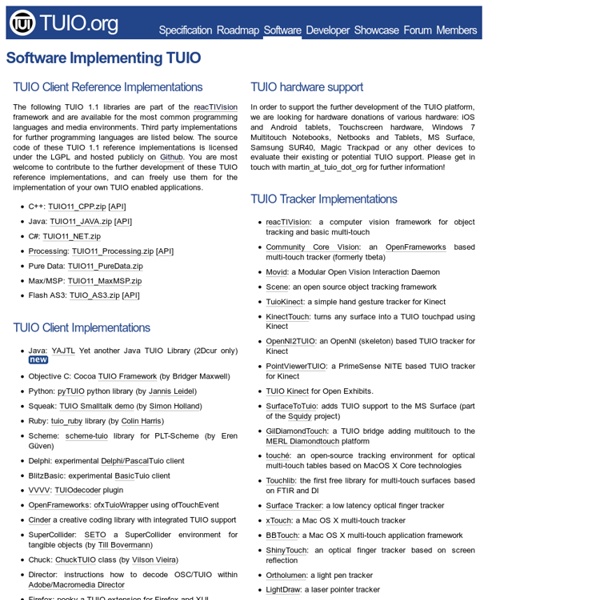Zoom
Trash
Related:



Accessing the kinect in javascript through websockets « Aboutme – blog Good morning all! (or evening, night, … depending on when you read this post of course). As you might know, I’ve been working on AIRKinect (as3nui.com) and I’ve got a side project AIRServer aswell (which allows you to setup air as a socket server, including websocket support). Wouldn’t it be fun, to combine these two projects in a demo, so you can access the kinect information through a websocket? In this demo, I’m just rendering the skeleton points in a canvas element, using three.js. I’ve uploaded the sources and included binary installers for the desktop application (windows 7, OSX Lion). Using the javascript client, you connect to your ip (if you’re testing on the same ip, 127.0.0.1 should be fine), and you can start dancing in the canvas element :-).
MT4j - Multitouch For Java reacTIVision Fiery Ferret Blog GestureML Get Sdk | Kinesis - build gesture apps Open Frameworks View topic - DIY multitouch plans & libs ! Regarding Microsoft's 'Surface', it's exciting but ... Quote: With a 30-inch screen, Surface will initially sell for between $5,000 and $10,000 (£2,525-£5,050). That's a bit expensive for me. I'm sure the price will drop in a few years at which point I will be (literally) all over it. The DIY option would be cheaper, the things you need are 1: a projector 2: a computer 3: a camera with a WDM driver 4: some infra red lighting (so it's out of the spectral range of the lightshow) 5: the table I guess cost depends to a large degree on whether you have a few items already. the camera they use is this one basically an OEM webcam / spycam device like I might buy from Maplin (UK) but why not get an all in one solution, camera and IR lights all in one. I'm guessing that the total (DIY) cost including the table would be £800 to £1000, but as the major cost is the projector if you already have one, then that would drop.
Putting our arms around the future of touch | Beyond Binary - CN SAN JOSE, Calif.--The success of Nintendo's Wii and Apple's iPod have shown the consumer appeal of devices that respond to human touch and movement, but a quick glance around the San Jose Hilton showed just how young the industry is. While this week's RSA 2009 show fills the Moscone Center a little ways up north in San Francisco, the Interactive Displays 2009 conference barely fills a mid-size ballroom here. Its show floor more closely resembles a science fair than the glitz of a big-time trade show. But if you used one of the interactive displays here to show a heat map of this industry, it would glow red hot. And while the show is small, the 270 attendees are more than the show's organizers had expected, leading to a shortage of dishes, but an abundance of energy. Among those young companies is a San Jose-based outfit called 22miles. With a swipe of his finger, CEO Joey Yu Zhao pulled up a prototype interactive TV application. It's intuitive, but tricky to master.